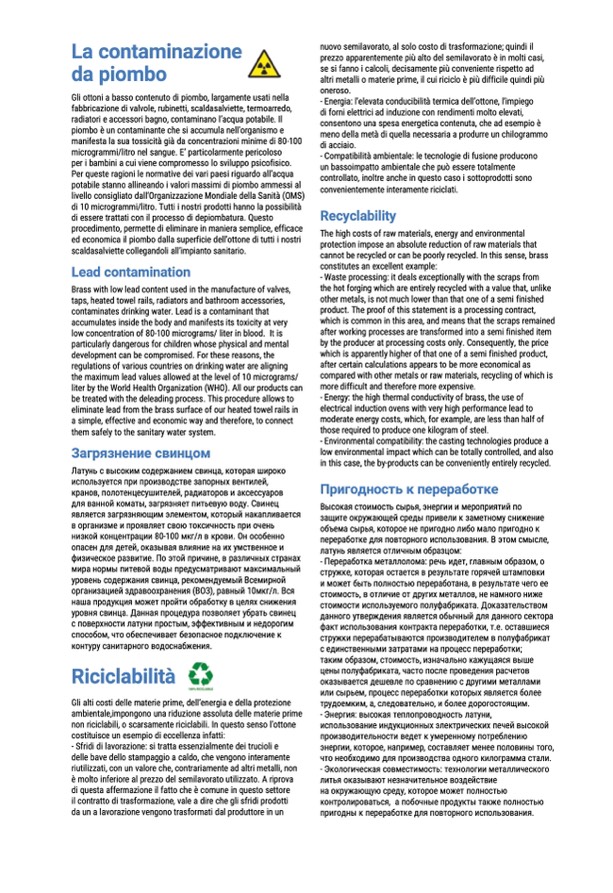
L
Gli ottoni a basso contenuto di piombo, largamente usati nella
fabbricazione di valvole, rubinetti, scaldasalviette, termoarredo,
radiatori e accessori bagno, contaminano l’acqua potabile. Il
piombo è un contaminante che si accumula nell’organismo e
manifesta la sua tossicità già da concentrazioni minime di 80-100
microgrammi/litro nel sangue. E’ particolarmente pericoloso
per i bambini a cui viene compromesso lo sviluppo psicofisico.
Per queste ragioni le normative dei vari paesi riguardo all’acqua
potabile stanno allineando i valori massimi di piombo ammessi al
livello consigliato dall’Organizzazione Mondiale della Sanità (OMS)
di 10 microgrammi/litro. Tutti i nostri prodotti hanno la possibilità
di essere trattati con il processo di depiombatura. Questo
procedimento, permette di eliminare in maniera semplice, efficace
ed economica il piombo dalla superficie dell’ottone di tutti i nostri
scaldasalviette collegandoli all’impianto sanitario.
Brass with low lead content used in the manufacture of valves,
taps, heated towel rails, radiators and bathroom accessories,
contaminates drinking water. Lead is a contaminant that
accumulates inside the body and manifests its toxicity at very
low concentration of 80-100 micrograms/ liter in blood. It is
particularly dangerous for children whose physical and mental
development can be compromised. For these reasons, the
regulations of various countries on drinking water are aligning
the maximum lead values allowed at the level of 10 micrograms/
liter by the World Health Organization (WHO). All our products can
be treated with the deleading process. This procedure allows to
eliminate lead from the brass surface of our heated towel rails in
a simple, effective and economic way and therefore, to connect
them safely to the sanitary water system.
анение синцо
Латун с всоким содержанием свина, котора ироко
исползуетс при производстве запорнх вентилей,
кранов, полотенесуителей, радиаторов и аксессуаров
дл ванной комат, загрзнет питеву воду. Свине
влетс загрзним лементом, которй накапливаетс
в организме и провлет сво токсиност при оен
низкой конентраии 80-100 мкг/л в крови. Он особенно
опасен дл детей, оказва влиние на их умственное и
физиеское развитие. По той приине, в разлинх странах
мира норм питевой вод предусматриват максималнй
уровен содержани свина, рекомендуемй Всемирной
организаией здравоохранени (ВОЗ), равнй 10мкг/л. Вс
наа продуки может пройти обработку в елх снижени
уровн свина. Данна проедура позволет убрат свине
с поверхности латуни простм, ффективнм и недорогим
способом, то обеспеивает безопасное подкление к
контуру санитарного водоснабжени.
Gli alti costi delle materie prime, dell’energia e della protezione
ambientale,impongono una riduzione assoluta delle materie prime
non riciclabili, o scarsamente riciclabili. In questo senso l’ottone
costituisce un esempio di eccellenza infatti:
- Sfridi di lavorazione: si tratta essenzialmente dei trucioli e
delle bave dello stampaggio a caldo, che vengono interamente
riutilizzati, con un valore che, contrariamente ad altri metalli, non
è molto inferiore al prezzo del semilavorato utilizzato. A riprova
di questa affermazione il fatto che è comune in questo settore
il contratto di trasformazione, vale a dire che gli sfridi prodotti
da un a lavorazione vengono trasformati dal produttore in un
nuovo semilavorato, al solo costo di trasformazione; quindi il
prezzo apparentemente più alto del semilavorato è in molti casi,
se si fanno i calcoli, decisamente più conveniente rispetto ad
altri metalli o materie prime, il cui riciclo è più difficile quindi più
oneroso.
- Energia: l’elevata conducibilità termica dell’ottone, l’impiego
di forni elettrici ad induzione con rendimenti molto elevati,
consentono una spesa energetica contenuta, che ad esempio è
meno della metà di quella necessaria a produrre un chilogrammo
di acciaio.
- Compatibilità ambientale: le tecnologie di fusione producono
un bassoimpatto ambientale che può essere totalmente
controllato, inoltre anche in questo caso i sottoprodotti sono
convenientemente interamente riciclati.
The high costs of raw materials, energy and environmental
protection impose an absolute reduction of raw materials that
cannot be recycled or can be poorly recycled. In this sense, brass
constitutes an excellent example:
- Waste processing: it deals exceptionally with the scraps from
the hot forging which are entirely recycled with a value that, unlike
other metals, is not much lower than that one of a semi finished
product. The proof of this statement is a processing contract,
which is common in this area, and means that the scraps remained
after working processes are transformed into a semi finished item
by the producer at processing costs only. Consequently, the price
which is apparently higher of that one of a semi finished product,
after certain calculations appears to be more economical as
compared with other metals or raw materials, recycling of which is
more difficult and therefore more expensive.
- Energy: the high thermal conductivity of brass, the use of
electrical induction ovens with very high performance lead to
moderate energy costs, which, for example, are less than half of
those required to produce one kilogram of steel.
- Environmental compatibility: the casting technologies produce a
low environmental impact which can be totally controlled, and also
in this case, the by-products can be conveniently entirely recycled.
иодность пееаботе
Всока стоимост ср, нергии и меропритий по
заите окружаей сред привели к заметному снижение
обема ср, которое не пригодно либо мало пригодно к
переработке дл повторного исползовани. В том смсле,
латун влетс отлинм образом:
- Переработка металлолома: ре идет, главнм образом, о
стружке, котора остаетс в резултате горей тамповки
и может бт полност переработана, в резултате его ее
стоимост, в отлиие от других металлов, не намного ниже
стоимости исползуемого полуфабриката. Доказателством
данного утверждени влетс обнй дл данного сектора
факт исползовани контракта переработки, т.е. оставиес
стружки перерабатватс производителем в полуфабрикат
с единственнми затратами на проесс переработки;
таким образом, стоимост, изнаално кажуас ве
ен полуфабриката, асто после проведени расетов
оказваетс деевле по сравнени с другими металлами
или срем, проесс переработки которх влетс более
трудоемким, а, следователно, и более дорогостоим.
- Энерги: всока теплопроводност латуни,
исползование индукионнх лектриеских пеей всокой
производителности ведет к умеренному потреблени
нергии, которое, например, составлет менее половин того,
то необходимо дл производства одного килограмма стали.
- Экологиеска совместимост: технологии металлиеского
лит оказват незнаителное воздействие
на окружау среду, которое может полност
контролироватс, а побоне продукт также полност
пригодн к переработке дл повторного исползовани.

